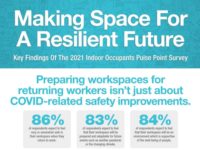A new survey by the American Institute of Architects (AIA) finds that a large majority of Americans (83 percent) consider public buildings—schools, libraries, community centers, and parks—part of their community’s infrastructure. And, 94 percent of those surveyed say that having well-maintained public buildings are important to the future of their community.
In a key finding for policy makers, 83 percent of survey respondents agreed that investment in these public buildings is just as important as investment in roads and bridges. The survey also found that seven in 10 Americans want their public buildings renovated, and almost three-quarters of Americans consider public schools in good condition a “must have” in the communities in which they live.
These are some of the major findings of the first-ever AIA survey of American attitudes toward essential community buildings. The survey results, conducted by The Harris Poll, were made public today at the AIA Build America Summit.
“The survey findings are a clarion call to policy makers at all levels of government that Americans not only want safe roads and bridges, but also desire a serious financial commitment to public buildings that mirror and contribute to the communities in which they live,” said AIA President Russell Davidson, FAIA.
“The purpose of the Build America Summit is to expand the infrastructure discussion to include funding to repair, restore, and adapt the essential public buildings that give communities character, said Davidson, who conceived the Summit. Nearly 40 speakers and 350 attendees from design and construction, real-estate, education, development, and government will develop recommendations that will be shared with the incoming Presidential Administration and made available to state and local governments and community leaders.
Major survey findings:
- More than three in four Americans (78 percent) think their local government should take some financial responsibility for supporting the investment in their public buildings. Just under two-thirds (61 percent) think state government should take some financial responsibility. A majority (53 percent) think that community members should support it, and almost half (46 percent) believe private entities should also invest.
- A majority of Americans believe that the condition of community buildings can lead to notable benefits, particularly higher property values (60 percent) and improved quality of education (62 percent).
- Sixty-nine percent of Americans believe schools are one of the most important buildings to receive a consistent level of public funding.
- On average, Americans feel about one third (34 percent) of public funds budgeted for community features should be allocated to public buildings and/or spaces. Of the remaining, they would allocate 37 percent to transportation and 29 percent to public housing.
- Significant gender differences exist in attitudes toward public buildings and spaces. For example, women are more inclined than men (44 to 34 percent) to consider public housing options a “must have.” Conversely, older men (44 percent) place the most emphasis on funding transportation.
- Almost half those surveyed (48 percent) believe public housing (defined as a combination of senior and affordable housing) is one of the most important community features to receive a consistent level of public funding.
“It is clear from the survey that Americans consider investment in community buildings and spaces a priority,” said AIA CEO Robert Ivy, FAIA. “Not only do they believe that that investment would lead to improvements in property value, education, and public safety, but also serve to attract new businesses and enhance their overall quality of life.”
A copy of the survey results can be found here.
This survey was conducted online within the United States by Harris Poll on behalf of The American Institute of Architects from October 12-14, 2016 among 2,108 U.S. adults ages 18 and older. This online survey is not based on a probability sample and therefore no estimate of theoretical sampling error can be calculated. For complete survey methodology, including weighting variables, please contact Michele Russo, senior director, AIA research (michelerusso@aia.org).



